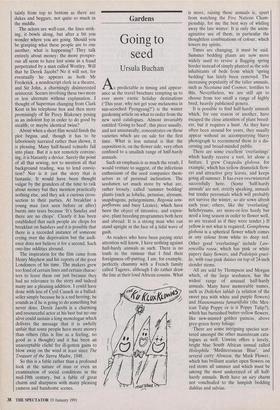Cinema
The Fool (`U', Curzon West End)
Too many stitches in time
Mark Amory
Accurate period detail is very depress- ing, which is a pity as it is something that the British are particularly good at. No- thing is more lowering to the spirits than a whole streetful of cars with running boards of just the right width, unless it is girls with curious hair-styles, particularly something that might be called sausage-curls — bits dangling down the front. It is as if there was a certain amount of imaginative effort available for each film and most of it has already been used up. Conversely, old films that just happen to show, say, a London street in the Fifties cannot help being fascinating, though at the expense of attention wandering from the story. And surprises can intrigue: I have been wonder- ing mildly ever since The Shooting Party whether the guns really stood that close to each other before the first world war or if it was a mistake, or if it was meant to evoke the coming trenches, or if it was convenient and the director simply did not care.
The Fool, directed and partly written by Christine Edzard, has more period detail than any film since her last, Little Dorrit. Indeed for a long time there appears to be nothing else. No running boards, for this is 1857, but a mass of elaborate clothes, and we are assured that as sewing-machines were not used then all the costumes have been hand-sewn. The number of characters and the social sweep are enormous, cer- 'Any messages, Miss Pringle?' tainly from top to bottom as there are dukes and beggars, not quite so much in the middle.
The actors are well-cast, the lines strik- ing, it bowls along, but after a bit you wonder where you are going. Should you be grasping what these people are to one another, what is happening? They talk entirely about money; the more prosper- ous all seem to have lost some in a fraud perpetrated by a man called Westley. Will that be Derek Jacobi? No it will not, for eventually he appears as both Mr Frederick, a nondescript clerk in a theatre, and Sir John, a charmingly disinterested aristocrat. Scenes involving these two more or less alternate without explanation. I thought of Superman changing from Clark Kent in his telephone box and then more promisingly of Sir Percy Blakeney posing as an indolent fop in order to do good by stealth; or maybe identical twins?
About when a short film would finish the plot begins and, though it has to be laboriously narrated rather than shown, it is pleasing. Many half-heard remarks fall into place. But it is not remotely convinc- ing, it is blatantly a device. Surely the point of all that sewing, not to mention all that background reading, was to lend convic- tion? Nor is it just the story that is fantastic. It would have been thought vulgar by the grandees of the time to talk about money but they mention practically nothing else, and they ask a curious cross- section to their parties. At breakfast a young man (not seen before or after) bursts into tears because 'It's Sunday and there are no chops'. Clearly it has been established that such people ate chops for breakfast on Sundays and it is possible that there is a recorded instance of someone crying over the deprivation but the audi- ence does not believe it for a second. Such one-line oddities abound.
The inspiration for the film came from Henry Mayhew and his reports of the poor Londoners of his time. The makers grew too fond of certain lines and certain charac- ters to leave them out just because they had no relevance to the story and indeed many are a pleasing addition. I could have done with less of Cyril Cusack as a ballad- seller simply because he is a red herring; he sounds as if he is going to do something but never does. Derek Jacobi is a charming and resourceful actor at his best but no one alive could sustain a long monologue which delivers the message that it is awfully unfair that some people have more money than others (this is fine as a feeling, no good as a thought) and it has been an unacceptable cliché for ill-gotten gains to blow away on the wind at least since The Treasure of the Sierra Madre, 1948.
So this is a fable rather than a profound look at the nature of man or even an examination of social conditions in the mid-19th century, but a fable of great charm and sharpness with many pleasing cameos and handsome scenes.



















































 Previous page
Previous page